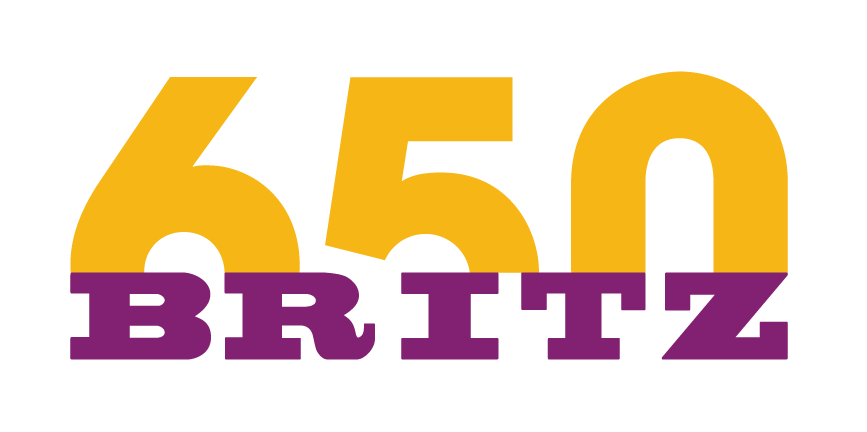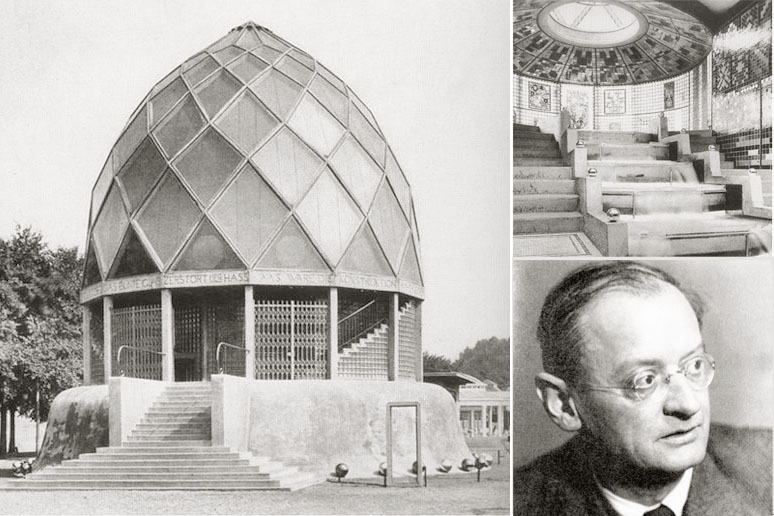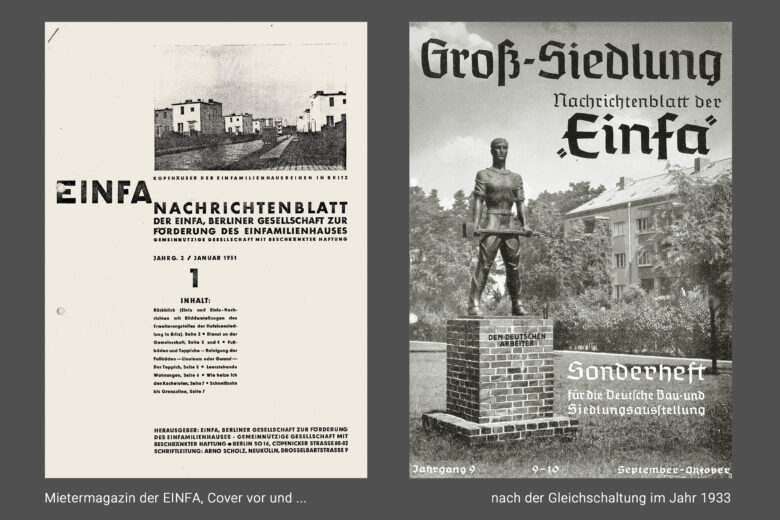October 17 - 19, 2025
100 years of the Horseshoe Estate - Conference with accompanying program
The Horseshoe Estate in Neukölln-Britz celebrates its 100th anniversary in 2025. It is not only the largest, but probably also the best-known complex of the UNESCO World Heritage "Estates of Berlin Modernism". Grouped around the eponymous horseshoe, the ensemble of terraced houses, multi-storey apartment buildings, open spaces and gardens, which was largely designed by Bruno Taut, was built in several phases between 1925 and 1930 and is part of the "Großsiedlung Britz". To mark the anniversary of the laying of the foundation stone in Britz, there will initially be a festival in July. This will be followed in October - as part of the "Triennial of Modernism" - by a conference with a dense program of exhibitions, film screenings, book presentations and guided tours, which will focus on the history and present of the famous ensemble as well as special monument work projects.

Conference "100 years of the Horseshoe Estate"
The Hufeisensiedlung is not only the largest and best-known UNESCO World Heritage site, but also the best-known part of the "Großsiedlung Britz". The estate was built by the housing association GEHAG and planned by the architect Bruno Taut, the garden architect Leberecht Migge and the later city planning officer Martin Wagner in a virtuoso, colorful and varied manner. As part of the programme, it becomes clear what makes the complex, which boasts many gardens, green and open spaces and a close neighbourhood and is now largely privatized, so instructive and relevant from today's perspective ...
These include, for example
- the transfer of the social and reformist ideals of the garden city movement into serial row construction,
- the political implementation of improved hygiene standards and a cost-cutting cycle construction process,
- the combination of serial design principles with a virtuoso use of color and construction variants,
- the successful urban combination of multi-storey apartments and terraced houses with gardens,
- the high quality of living with a close neighborhood - already stimulated in the urban design,
- the deliberately staged model and symbolic character of the estate as a "showpiece" of Neues Bauen, and
- the politically and logistically far-sighted, clever and broad-based implementation by the GEHAG housing association, which was founded in 1924 specifically to combat the rampant housing shortage and whose balance sheet continues to set standards in terms of quality and quantity to this day.
It also has an eventful history, which is exemplary of the German course of time and shifts in power from the 1930s onwards: Shortly after the National Socialists came to power, GEHAG was "brought into line" by the new rulers and then transferred to the ownership of the state after the end of the Second World War. In the 1980s, the ensemble was placed under protection and upgraded as a historical monument. The privatization and subsequent stock market transfer of the GEHAG portfolio in 1998 gave rise, with a slight time lag, to special challenges and exemplary model projects. These relate to the homogeneous preservation of the Britz ensemble - which has now been extensively transferred into hundreds of individual properties - and the concrete and tangible communication of Taut's legacy. All of this will be presented, explained, discussed and viewed during the event. The highlight is the symposium on Sunday, for which you can download a save-the-date as a digital calendar entry (e.g. in iCal) here.
Everyone is welcome! The free event is aimed at both long-established and new residents of the World Heritage Site, as well as students, experts and the general public.
Program 17 - 19.10.2025
still in planning, details to follow
Friday, 17.10.2025:
Vernissage and Opening
- 18.00 - 18:15: Greetings and brief introduction to the topic
- Opening of the special exhibition in the Infostation: "From design training to Nazi propaganda - the tenant magazines of EINFA and GEHAG 1930-1939": The exhibition is dedicated to the monthly tenant magazines published by EINFA from 1930-1939. This was part of the GEHAG housing association and reflects the upheavals in the politics of the company, which emerged from the left-wing and pro-union political spectrum. Until mid-1933, the magazines primarily focused on house and garden, functional furnishings and healthy living. After GEHAG was brought into line, the layout and later the content changed in favor of typical Nazi propaganda.
- 19:30 / Evening program: Film screening(s) on the World Estates Estates
- Venue: Infostation Hufeisensiedlung, Fritz-Reuter-Allee 44, 12359 Berlin
Saturday, 18.10.2025:
Guided tours, book presentation, keynote event
- 11.00 - 13.00: Architecture tours with different focuses and guides:
Starting point: Hufeisensiedlung information station, Fritz-Reuter-Allee 44, 12359 Berlin. The tours last around one and a half to two hours and are dedicated to aspects of building, contemporary, social, cultural, urban and architectural history. If there is greater demand, thematically focused, target group-specific or English-language tours are also conceivable. Possible themed tours would then be "Living in the World Heritage Site" (FFHBB e.V.), "Utopia and Idyll" (Henning Holsten), "GEHAG Housing" (Steffen Adam), "Gardens, Green and Open Spaces" (Katrin Lesser) and "Architecture, History, Challenges and Projects" (Ben Buschfeld). - 13.15 - 14.00: Curator-guided tours; at the end of the tours there is the opportunity to visit the rentable museum TAUTES HEIM, with an explanation by the private operators Katrin Lesser and Ben Buschfeld
- 14.00 - 15.30: Book presentation TAUTES HEIM - Story & Details. with reading and discussions, details and participants for this part of the event will be announced. Registration is required. (The address will be announced individually.) -
- 14.00 - 15.45 - Alternatively: opportunity for self-organized snacks and/or a visit to the permanent and special exhibition in the Hufeisensiedlung information station
- 16:00: Keynote lecture or talk on "100 years of Neues Bauen in Berlin" (local venue: possibly Hufeisensiedlung information station, Gutshof Britz or nearby - details, speakers and/or participants to be announced)
- Afterwards: get together
- Venues: Infostation Hufeisensiedlung (Fritz-Reuter-Allee 44), TAUTES HEIM (address upon registration), possibly other lecture venue
Sunday, 19.10.2025:
Symposium for interested parties
- 9.30 - 10.00 a.m.: Arrival at the conference venue:
Kulturstall Britz - Schloß und Gutshof Britz, Alt-Britz 81-89, 12359 Berlin, Directions by public transport: Bus M46 / M44 to "Fulhamer Allee" or U7 to "Parchimer Allee" + 700 meters on foot. - 10.00 - approx. 18.30: Symposium "100 YEARS OF HUFEISENSIEDLUNG"
The symposium will be divided into different thematic sections lasting a good 1 hour, each with around 4 image and specialist presentations. All titles are working titles. Details and participants will follow:- Section I: Prehistory, context and urban development
(650 years of Britz, Greater Berlin, housing shortage, reform housing, etc.) - Section II: 1924-1945: Players at the time of construction, foundation and Gleichschaltung
(Neues Bauen, GEHAG, Bruno Taut, Martin Wagner, Nazi era, etc.) - Section III: 1945-2010: Rediscovery and valorization
(expert opinions, monument registrations, restoration, etc.) - Section IV: 1998-2025: Privatization and the current situation
(privatization, attitude to life, initiatives and model projects)
- Section I: Prehistory, context and urban development
- There will be breaks and space for discussion during the program. The event is aimed at residents and the general public. Residents of similar ensembles are also very welcome. The conference venue is the Kulturstall on the grounds of the neighboring Britz estate
- A temporary exhibition on the six "Estates of Berlin Modernism" World Heritage sites will be shown in the foyer.
On the subject
100 years of the Horseshoe Estate
Six Estates of Berlin Modernism were jointly declared a UNESCO World Heritage Site in 2008. This title means that they are considered to have "outstanding universal value for the history of mankind". Wow, but is it just simple housing?
To answer this question, it helps to look back in history and compare the situation with our own needs today. The six World Heritage Estates were created in response to the housing shortage that was rampant in many European cities and industrial conurbations at the beginning of the 20th century. They established higher hygienic standards and new forms of urban development with plenty of green and open spaces.
What was the planning about? - Even today, these Estates are popular residential areas - and are rightly regarded as Berlin's most important contribution to architectural history. At the time, many questions were not only asked here, but also answered in an exemplary manner - questions that still concern us today, such as: "How do we want to live?", "What constitutes good living?", "What can architecture and urban planning contribute to this?", "How can better hygienic conditions be created?", "How can good neighbourliness be stimulated?", "How do I counter the constant threat of monotony in serial construction?" or "How can new, convincing concepts be implemented financially, organizationally and politically?"
What distinguishes the two parts of the "Großsiedlung Britz"? - Of the six Estates designated as UNESCO World Heritage Sites, the Horseshoe Estate, comprising almost 2,000 residential units, is not only the largest, but also the best-known and most challenging ensemble in terms of monument preservation. Even at the time of its construction, the large estate in Neukölln-Britz functioned as a divided "showplace". Two political camps and their respective sponsored housing associations GEHAG and DEGEWO competed here, each pursuing their own aesthetic models and implementation strategies. Under the direction of Bruno Taut, the chief architect appointed by the politically cleverly constructed and secured housing association GEHAG, new forms of urban planning were tested and components developed in the Hufeisensiedlung, which were later used again, slightly varied, in all kinds of parts of the newly created "unified municipality of Gross-Berlin".
European contemporary history, bridge-building and symbol - The urban development in Britz scaled the principles of the garden city concept originating in England with cooperative sponsorship, better hygienic standards and gardens that could be used for self-sufficiency. The ideals of new regional planning defined by the British architectural theorist Ebenezer Howard were translated by GEHAG and its chief architect Bruno Taut into urban multi-storey housing, which could be built in large numbers and in a time- and cost-saving manner using serial construction methods and was carried out by the Berliner Bauhütte, which was affiliated with GEHAG. This transformation becomes particularly clear when comparing the six individual construction phases built between 1925 and 1930, which are included in the World Heritage List. The estate, grouped around the iconic 350-metre-long horseshoe row that gives it its name, is also an instructive mirror of the controversies and upheavals of later decades. Not only the discourse on urban development in the early 20th century can be traced here, but also the policy of conformity practiced by the Nazi state, the planned conversion to a Nazi model estate and the typical liberal economic spirit of the late 1990s and its consequences.
Privatization, civil society and model character - Following the sale of GEHAG in a bidding process initiated by the state of Berlin in 1998 and several subsequent transactions on the financial market, the terraced houses with gardens of the Hufeisensiedlung, which dominate the streetscape, were successively converted into individual private ownership. This massive challenge for the homogeneous preservation of the iconic and historic ensemble led to numerous initiatives, projects and publications that were initiated and developed by the residents. They have endured ever since and can thus also serve as examples for comparable complexes in terms of civic participation, practical monument preservation and active mediation. These approaches will also be reported on at the conference and during the tours.
Further points of reference
100 years of Neues Bauen - Due to the significance of the Hufeisensiedlung, the anniversary in Britz is also representative of the momentum and housing construction at the time of classical Modernism - an anniversary that can best be seen in the particularly prominent buildings of the era and which is also celebrated in a similar way in Frankfurt, Dessau and Magdeburg as well as several other major European cities. Although the term was coined as early as 1919 in a publication by architect Egon Erwin Gutkind, Neues Bauen was not implemented on a large scale until 1924/25.
50 years of the European Year of Monument Conservation - this is the title of another anniversary related to the topic, which will also play a role in the program of the Triennial of Modernism 2025. The year 1975 is regarded by experts as the beginning of modern heritage conservation. The developments and activities in Britz are a prototype of the catalytic role that civic engagement can play, particularly in inhabited monuments.
650 years of Britz - The Hufeisensiedlung is part of the Britz district, which was first mentioned in a document in 1375. In addition to the Hufeisensiedlung, the three main sights of the district, which is now part of Neukölln, include the former BUGA grounds of the Britzer Garten and the idyllic ensemble of Britz Castle and Britz Manor(used here as a conference venue).
Further information on world heritage and settlement
Organizer

Association of Friends and Sponsors of
Hufeisensiedlung Berlin-Britz (FFHBB e.V.)
c/o Infostation Hufeisensiedlung
Fritz-Reuter-Allee 44, 12359 Berlin
Förderverein | Opening hours Infostation
Curation and organization
Ben Buschfeld, buschfeld.com - graphic and interface design / Tautes Heim / Triennial of Modernism / Deutscher Werkbund /
FFHBB e.V. / KulturerbeNetz.Berlin / Docomomo Germany
buschfeld.com | tautes-heim.de | LinkedIn
Office +49 (0)30-25922963


Promoted by


Further events

Overview of the parties involved

Impressions

Aerial photo, 2014 (Photo: Ben Buschfeld)

Settlement life, around 1940 (private archive)

2000-2025: Individual sales (Photo: Ben Buschfeld)

2011: Café + exhibition (Photo: Katrin Lesser)

Bruno Taut's early work, 1914 (public domain)

Tenant magazines 1930/33 (Tautes Heim private archive)

2007: Foundation of the association (Photo: FFHBB)

2012: Rentable museum (Photo: Tautes Heim)

Construction phase I, end of 1925 (public domain)

Postcard, 1960s (private archive)

2008: Unesco World Heritage Site (Photos: Ben Buschfeld)

Since 2002: Guided tours of monuments (Photo: Katrin Lesser)
Further anniversary events
All year round: 650 years of Britz
The Hufeisensiedlung is part of the historic district of Britz. Alongside Böhmisch-Rixdorf around Richardplatz, it is one of the longest-settled areas in today's Neukölln district. The history of the village goes back to an old manor that was first mentioned in a document in 1375 and will therefore be celebrating its 650th anniversary in 2025 with a large number of individual events. In addition to the UNESCO World Heritage Horseshoe Settlement, Britz Castle and Britz Manor as well as the extensive, varied park landscape of Britzer Garten are other main attractions of the district. The Britzer Garten was laid out in 1985 as a Federal Garden Show, and the idyllic ensemble of Britz Palace, garden and estate is home to several cultural institutions. In addition to these three main attractions, there are various smaller associations that contribute their activities to the program. The overall picture of almost 200 events in the district - located three stations outside the S-Bahn ring - is quite different from the general, rather urban-rough image of the administrative district of Neukölln, which has a population of almost 380,000. The central ceremony will take place on Sunday, July 20 as part of the summer festival at Gutshof Britz.
23-26.7.2025: Festival "Estates of Berlin Modernism"
The World Heritage Festival initiated by the Berlin State Monuments Office, which began in summer 2024 with a festival in the Schillerpark estate, is entering its second edition. In cooperation with Vonovia SE, the Association of Friends and Sponsors of the Hufeisensiedlung Berlin Britz, the rentable museum Tautes Heim, the Stegreif Orchestra and other important partners, this year's festival will take place in the Hufeisensiedlung from July 23 to 26, 2025. Under the motto "Experience architecture - live community", the four-day program spans an arc from the holistic visions of the 1920s to the present day of the inhabited monument ensemble. The varied program includes several public and private salons, concerts and musical performances, house and estate tours, activities for children and a central ceremony.
- www.berlin.de/landesdenkmalamt/aktivitaeten/kurzmeldungen/2025/artikel.1574021
- Press response to the 100th anniversary of the laying of the foundation stone (Selection - according to chronology)
- https://www.inforadio.de/rubriken/kultur/beitraege/2025/07/hufeisensiedlung-berlin-100-geburtstag.html
- https://www.baunetz.de/meldungen/Meldungen-Festival_in_Berlin_9985755.html?action=kommentieren
- https://www.tip-berlin.de/stadtleben/architektur/welterbefestival-2025-so-feiert-britz-die-hufeisensiedlung/
- https://www.radiodrei.de/programm/schema/sendungen/radio3_am_morgen/archiv/20250723_0600/radio3_aktuell_0940.html
- https://www.rbb24.de/panorama/beitrag/2025/07/berlin-hufeisensiedlung-neukoelln-britz-wohnungsbau-wohnen-100-jahre.html
- https://www.tagesspiegel.de/berlin/architektur-100-jahre-hufeisensiedlung-festival-im-berliner-welterbe-14069639.html
- https://www.rbb-online.de/abendschau/videos/20250723_1930/einhundert-jahre-hufeisensiedlung.html
- https://www.radiodrei.de/programm/schema/sendungen/radio3_am_nachmittag/archiv/20250723_1600/radio3_aktuell_1720.html
- https://www.tagesschau.de/inland/regional/berlin/rbb-100-jahre-hufeisensiedlung-in-berlin-britz-denkmal-des-sozialen-wohnungsbaus-100.html
- https://www.ardmediathek.de/video/rbb24-abendschau/rbb24-abendschau-vom-23-07-2025/rbb/Y3JpZDovL3JiYl81ZWE5NWI3OC1lZjdiLTRjZDctOThiYy02ZDZiMGQyNDRlMGNfcHVibGljYXRpb24
- https://www.radioeins.de/programm/sendungen/modo1619/_/berlin-100-jahre-hufeisensiedlung.html
- https://www.morgenpost.de/bezirke/neukoelln/article409571095/100-jahre-licht-luft-und-sonne-diese-siedlung-setzte-massstaebe.html
- https://berliner-abendblatt.de/berlin-news/100-jahre-hufeisensiedlung-festival-im-berliner-welterbe-id298717
- https://www.sueddeutsche.de/kultur/architektur-100-jahre-hufeisensiedlung-festival-im-berliner-welterbe-dpa.urn-newsml-dpa-com-20090101-250723-930-829111
- https://www.bz-berlin.de/berlin/neukoelln/hufeisensiedlung-britz
- https://www.bz-berlin.de/meinung/hier-ist-neukoelln-vorbild
- https://entwicklungsstadt.de/100-jahre-hufeisensiedlung-soziales-vorzeigeprojekt-mit-anhaltender-strahlkraft/
- https://www.nd-aktuell.de/artikel/1192887.berlin-neukoelln-hufeisensiedlung-in-britz-ein-gluecksbringer-fuer-mieter.html
